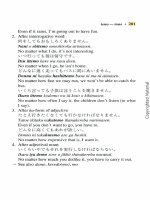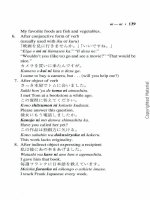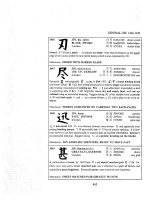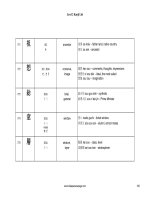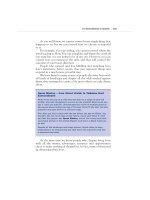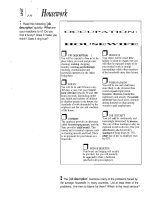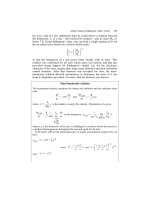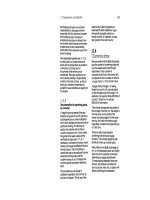Essentials of Process Control phần 8 ppsx
Bạn đang xem bản rút gọn của tài liệu. Xem và tải ngay bản đầy đủ của tài liệu tại đây (3.16 MB, 55 trang )
424
IVK~~‘IIKEI::
Frequency-Domain Dynamics and Control
(a) Sketch Bode and Nyquist plots
for
this process for a gain K,, = I and a deadtime
1)
= 0.5 minutes.
(b) Calculate the ultimate frequency o,, and ultimate gain K,, ctnalyticdly for arbi-
trary values of gain and deadtime, and confirm your results
gt-aphictrl/>~
using the
Bode plot from part (a) for the specific numerical values given.
(c) Calculate analytically and graphically the value of controller gain that gives a
phase margin of 45”.
(d) Use a Nichols chart to determine the maximum closedloop log modulus if the
gain calculated in part (c) is used.
(e) Calculate the TLC settings for a PI controller (K,. = KJ3.2; r/ =
2.2P,,)
and
generate a Bode plot for
GMGc
when these controller constants are used.
(f) What are the phase margin, gain margin, and maximum closedloop log modulus
when this PI controller is used?
11.45.
A process has the following
openloop
transfer function between the controlled variable
Y and manipulated variable M:
(a) If a proportional analog controller is used, calculate the ultimate gain and ultimate
frequency for the numerical values
K,,
= 2,
70
= 10, and
D
= I.
(6) Sketch Nyquist and Bode plots of G
M(iwj.
Calculate the value of controller gain
that gives a phase margin of 45”.
(c) Use a Nichols chart to determine the maximum closedloop log modulus if the
controller gain is 3.19.
11.46. A process has an
openloop
transfer function that is a double integrator.
(a) Using a root locus plot, show that a proportional feedback controller cannot pro-
duce a closedloop stable system.
(b) Using frequency-domain methods, show the same result as in (a).
11.47. The
openloop
transfer function for a process is
KO
GM(~)
=
~
7,s + 1
(a) If a proportional-only controller is used, calculate the closedloop servo transfer
function Y/pet, expressing the closedloop gain
Kc,
and closedloop time constant
T,I
in terms of the
openloop
gain
Ko,
the
openloop
time constant
TV,,
and the con-
troller gain K, Sketch a closedloop log modulus plot for several values of con-
troller gain.
(b) Repeat part (n) using a proportional-integral feedback controller with reset time
r/ =
7,.
11.48. The
openloop
transfer function
G
M(.sJ
of a process relating the controlled variable
Yc,~,
and the manipulated variable
Mc,s,
is a gain K,, = 3 (with units of mA/mA when
i
(*rr~rwiK
f
r:
FrcqLrcncy-l)ortlairl Analysis
of‘C/osctl/oop
SysIcrm
425
transmitter and valve gains have been included) and two lirst-order lags in series with
time constants
71
= 2 min and
72
= 0.4 min.
(n) If a proportional controller is used, sketch a root locus plot.
(h) Calculate the controller gain that gives a closedloop damping coefficient of 0.3.
(c) What is the closedloop time constant when this gain is used?
(d) Make a Bode plot of the
openloop
system.
(e) Using a controller gain of 6.3, calculate the phase margin analytically and graph-
ically.
11.49. A deadtime element (D = 0.
I
min) is added in series with the lags in the process
considered in Problem
I
I
.48.
(a) Make a Bode plot of the
openloop
system with a proportional controller and
Kc
=
I.
(h) Determine graphically the ultimate frequency and the ultimate gain.
(c)
Determine graphically the phase margin if a controller gain of 6.3 is used.
(d) Determine graphically the maximum closedloop log modulus if a controller gain
of 6.3 is used.
(e) Calculate the Tyreus-Luyben settings for a PI controller.
(.f‘)
Determine graphically the phase and gain margins when these settings are used.
sfer
tant
:on-
:on-
ime
able
#hen
PART FOUR
“, .,
.
Multivariable Processes
Perhaps the area of process control that has changed the most drastically in the last
two decades is multivariable control. This change was driven by the increasing oc-
currence of highly complex and interacting processes. Such processes arise from
the design of plants that are subject to rigid product quality specifications, are more
energy efficient, have more material integration, and have better environmental per-
formance. The tenfold increase in energy prices in the 1970s spurred activity to make
chemical and petroleum processes more efficient. The result has been an increasing
number of plants with complex interconnections of both material flows and energy
exchange. The control engineer must be able to design control systems that give
effective control in this multivariable environment. Multivariable systems contain
more than one controlled variable and manipulated variable (the type of system we
have studied so far).
We need to learn a little bit of yet another language! In previous chapters we
have found the perspectives of time (English), Laplace (Russian), and frequency
(Chinese) to be useful. Now we must learn some matrix methods and their use in the
“state-space” approach to control systems design. Let’s call this state-space method-
ology the “Greek” language.
The next two chapters are devoted to this subject. Chapter 12 summarizes some
useful matrix notation and discusses stability and interaction in multivariable sys-
tems. Chapter 13 presents a practical procedure for designing conventional multiloop
SISO controllers (the diagonal control structure).
It should be emphasized that the area of multivariable control is still in an early
stage of development. Many active research programs are under way around the
world to study this problem, and every year brings many new developments. The
methods and procedures presented in this book should be viewed as a summary of
some of the practical tools developed so far. Improved methods will undoubtedly
grow from current and future research.
477
I
1
I
C HAPTER 12
Matrix Representation and Analysis
12.1
MATRIX REPRESENTATION
Many books have been written on matrix notation and linear algebra. Their elegance
has great appeal to many mathematically inclined individuals. Many hard-nosed en-
gineers, however, are interested not so much in elegance as in useful tools to solve
real problems. We attempt in this chapter to weed out most of the chaff, blue smoke,
and mirrors. Only those aspects that we have found to have useful engineering ap-
plications are summarized here. For a more extensive treatment, the readable book
Control System Design: An Introduction to State-Space Methods by Bernard Fried-
land (1986, McGraw-Hill, New York) is recommended.
We use the symbolism of a double underline (A) for a matrix and a single un-
derline (x) for a vector, i.e., a matrix with only one
zlumn.
This helps us keep track
of which-quantities are matrices, which are vectors, and which are scalar terms.
We assume that you have had some exposure to matrices so that the standard
matrix operations are familiar to you. All you need to remember is how the inverse
of a matrix, the determinant of a matrix, and the transpose of a matrix are calculated
and how to add, subtract, and multiply matrices.
12.1.1 Matrix Properties
A host of matrix properties have been studied by the mathematicians. We discuss
only the notions of “eigenvalues” and “singular values” since these are valuable
in our design methods for multivariable systems. Eigenvalues is simply another
name for the roots of the characteristic equation of the system. Singular values give
us a measure of the size of the matrix and an indication of how close it is to be-
ing “singular.” A matrix is singular if its determinant is zero. Since the determinant
1’9
430
PAW
IWCJK:
Multivariable Processes
appears in the denominator when the inverse of a matrix is taken
[
Eq. (
12.
I
)],
the
inverse will not exist if the matrix is singular.
rg-’
=
[Cofactor[&])
IT
Det A
(12.1)
=
A. Eigenvalues
The eigenvalues of a square N x N matrix are the N roots of the scalar equation
I I
Det[hL
-
A] = 0
(12.2)
where A is a scalar quantity. Since there are N eigenvalues, it is convenient to define
the vector
A,
of length N, that consists of the eigenvalues:
Al,
AZ,
A3,
. . . ,
AN.
(12.3)
We use the notation that the expression
AtA]
means the vector of eigenvalues of the
-
matrix 4. Thus, the eigenvalues of a
matriG
[i
+
GM
Gc] is written
&,+G~
cc].
=
=xE==
EX A MPLE
12.
I. Calculate the eigenvalues of the following matrix A.
=
A=
=
(12.4)
Det[AL
-
&]
= 0
Det[AZ
-
A] = Det
(A + 2)
0
-2
(A
+ 4)
1
= (A +
2)(A
+ 4)
-
(O)(-2)
=
=
A’ +
6A
+ 8 = 0 = (A +
2)(A
+ 4)
The roots of this equation are A = -2 and A = -4. Therefore, the eigenvalues of the
matrix given in Eq. (12.4) are A, = 2 and
A2
= -4.
-2
hl$
=
-4
[
1
(12.5)
n
It might be useful at this point to provide some motivation for defining such
seemingly abstract quantities as eigenvalues. Consider a system of N linear ordinary
differential equations that model a chemical process.
ion
1.2)
ine
3)
the
the
!.4)
the
3
H
ch
1rY
CIIAIWK
12,
Matrifx
Representation and Analysis
431
dX
-zz=
Ax+Bu
dt
=-
=
(12.6)
where x = vector of the N state variables of the system
A
= N X
N
matrix of constants
=
B = a different N X A4 matrix of constants
z
= vector of the
M
input variables of the system
-
We show in Section 12. I
.3
that the eigenvalues of the A matrix are the roots of
the characteristic equation of the system. Thus, the eigenTalues tell us whether the
system is stable or unstable, fast or slow, overdamped or underdamped. They are
essential for the analysis of dynamic systems.
B. Singular values
The singular values of a matrix are a measure of how close the matrix is to being
“singular,” i.e., to having a determinant that is zero. A matrix that is N X N has N
singular values. We use the symbol
(pi
for a singular value. The largest magnitude
Cri
is called the maximum singular value, and the notation
amax
is used. The smallest
magnitude
gi
is called the minimum singular value
(amin).
The ratio of the maximum
and minimum singular values is called the “condition number.”
The N singular values of a real N X N matrix (i.e., all elements of the matrix are
real numbers) are defined as the square root of the eigenvalues of the matrix formed
by multiplying the original matrix by its transpose.
ai[A]
=
J
h[ATA]
i =
1,2, ,N
(12.7)
=
==
12.1.
E
x
A M P L E
12.2.
Find the singular values of the A matrix from Example
=
2
=
[i2
!T4]
LT
=
[-lj2
i4]
To get the eigenvalues of this matrix we use Eq. (12.2).
Det[A[
-
bT4] = 0
8
(A
-
16)
1
= 0 = (A
-
8)(A
-
16)
-
64
A’
-
24h + 128
-
64
=
0 =
A*
-
24A
+
64
A, = 20.94
A2
= 3.06
CT]
=
J%iFi
= 4.58 02 =
J3.06
= 1.75
(12.8)
(12.9)
Neither of
these
singular values is small, so the matrix is not close to being singular. The
determinant of A is 8, so it is indeed not singular. n
Z-Z
432 PART FOUR: Multivariable Processes
EXAMPLE 12.3. Calculate the singular values of the matrix
A=
-1
1
=
[
I
1
-1
Note that the determinant of this matrix is zero, so it is singular.
1
AT
=
I’
-i
=
[
1
ATA
=
[I’
!J[l’
II]
=
[_‘,
-;“I
==
Det[AZ
-
ATA] = 0
=
==
2
=
=
-
-
-
(A
-
2)
I
0 (A
2)(h
2) 4
A2
-
4A
f
4
-
4 =
A(A
-
4) = 0
A,=0
h2=4
a,=0
a*=2
The singular value of zero tells us that the matrix is singular.
n
The singular values of a complex matrix are similar to those of a real matrix.
The only difference is that we use the conjugate transpose.
Oi[A] =
=
Jh%$j
i
=
1,2, ,N
(12.10)
First we calculate the conjugate transpose (the transpose of the matrix with all of
the signs of the imaginary parts changed). Then we multiply A by it. Then we cal-
culate the eigenvalues. These can be found using Eq. (12.2)
f;
simple systems. In
more realistic problems we use MATLAB or the
1MSL
subroutine EIGCC. Note
that the product of a complex matrix with its conjugate transpose gives a com-
plex matrix (called a “hermitian” matrix) that has real elements on the diagonal
and has real eigenvalues. Thus, all the singular values of a complex matrix are real
numbers.
EXAMPLE 12.4. Calculate the singular values of the complex matrix
A
=
(1
+ 4
(1
+ 9
=
[
(2+i)
(1
+i)
ACT
=
t1
+>
(2-i)
=
(1
-i)
(1 -i)
ACTA
=
(1-i)
(1
+i)
(1
ti)
=
7
(5 + i)
= =
(1-i)
(l+i)
I
[
(5
-
i)
4
1
Det[Al
-
ACTA]
= 0
=
cc
1 0
0
1
I
i
7
-
(5
-
i)
(5 + 9
=
o
4
II
(12.11)
n
ix.
lo)
of
al-
In
)te
n-
i
al
:a1
1)
CIIAIW:.I~
12.
Matrix Representation and Analysis
433
Det (A-7)
[
(-5-i)
=()
(-5
+
i)
(A
-
4)
1
A*-lIA+28-2S-I=A*-llA+2=0
A, = 10.63
A2
= 0.185 uI = 3.29
CT~
= 0.430
Note that the singular values are real.
12.1.2 Transfer Function Representation
A. Openloop system
Let us first consider an
openloop
process with
iV
controlled variables, N ma-
nipulated variables, and one load disturbance. The system can be described in the
Laplace domain by N equations that give the transfer functions showing how all
of the manipulated variables and the load disturbance affect each of the controlled
variables through their appropriate transfer functions.
YI
= G~,,rnl +
G~,?rn2
+
+
GM,,,,mN
+
GL,L
Y2
=
GM,,
ml
+
GMz2rn2
+ . . . +
GM2,,,mN
+
GL,*
L
(12.12)
YN
=
GM,,
ml
+
GMN2m2
+
. . . +
GMNNmN
+
GL+
L
All the variables are in the Laplace domain, as are all of the transfer functions. This
set of N equations is very conveniently represented by one matrix equation.
Y
=
G~(,p(s)
+
&s+(s)
-
__I
(12.13)
where Y = vector of N controlled variables
Cl
= N X N matrix of process
openloop
transfer functions relating the con-
trolled variables and the manipulated variables
m = vector of N manipulated variables
GL
= vector of process
openloop
transfer functions relating the controlled
-
variables and the load disturbance
Lt,)
= load disturbance
These relationships are shown pictorially in Fig. 12.1. We use only one load variable
in this development to keep things as simple as possible. Clearly, there could be sev-
eral load disturbances, which would just appear as additional terms to Eqs. (12.12).
Then
Lc,r,
in Eq. (12.13) becomes a vector, and
CL
becomes a matrix with N rows
and as many columns as there are load disturbances. Since the effects of each of the
434
PAK-~
IUIK:
Multivariabic
Processes
load disturbances can be considered one at a time, we do it that way to simplify
the mathematics. Note that the effects of each of the manipulated variables can also
be considered one at a time if we were looking only at the
openloop
system or if we
were considering controlling only one variable. However, when we go to a multivari-
able closedloop system, the effects of all manipulated variables must be considered
simultaneously.
B. Closedloop system
Figure 12.2 gives the matrix block diagram description of the
openloop
system
with a feedback control system added. The
I
matrix is the identity matrix. The
s(S)
matrix contains the feedback controllers. M&t industrial processes use conventional
single-input, single-output (SISO) feedback controllers. One controller is used in
each loop to regulate one controlled variable by changing one manipulated variable.
In this case the
Gets)
matrix has only diagonal elements. All the off-diagonal ele-
ments are zero.
Gc, 0
-0.
0
Gc(s) =
0 Cc2 0 . . .
. . . . . . . . . . . . . . . . . . . . . .
1
(12.14)
I
0
. . .
0
GCN]
whereGcr,GC2, ,
GcN
are the individual controllers in each of the
N
loops. We
call this multiloop SISO system a “diagonal controller” structure. It is important to
recognize right from the beginning that having multiple SISO controllers does not
mean that we can tune each controller independently. As we will soon see, the dy-
namics and stability of this multivariable closedloop process depend on the settings
of all controllers.
Controller structures that are not diagonal but have elements in all positions in
the
S(s)
matrix are called multivariable controllers.
Gcw
=
-
i
Gc21 Gc22
*
*.
GUN
.
.
.
.
.
.
.
.
.
.
.
.
.
.
.
.
.
.
.
.
.
.
.
.
.
.
GCNI
GcN:!
.
*.
GCNN
(12.15)
The feedback controller matrix gives the transfer functions between the manip-
ulated variables and the errors.
m
=
Gc&
(12.16)
-
FIGURE 12.2
nplify
n
also
ifwe
.ivari-
dered
/stem
Gc(s)
:ional
ed in
.able.
I ele-
2.14)
. We
nt to
s
not
:
dy-
;ings
1s
in
15)
nip-
.16)
cwmt:.K
I
2.
Matrix Representation and Analysis
435
Since the errors are the differences between setpoints and controlled variables,
m =
&(,)[YSC’
-
Y]
-
-
Substituting for
m
in Eq. (12.13) gives
-
(12.17)
Y
=
G~(s)Gc(.s,[yS~’
-
xl
+
&s)Q.s)
-
-
=
Bringing all the terms with
y
to the left side gives
(12.18)
(12.19)
rf
+
&f(&(s,lY
=
&4(.&c(s)Yset
+
GLda
(12.20)
y
=
-
[I
+
hf(~&s)l-‘~(s,Gccs,
ret
=
-
-
I
(12.21)
Equation (12.2 1) gives the effects of setpoint and load changes on the controlled
variables in the closedloop multivariable environment. The matrix (of order
iV
X
N)
multiplying the vector of setpoints is the closedloop servo transfer function matrix.
The matrix (N X 1) multiplying the load disturbance is the closedloop regulator trans-
fer function vector.
It is clear that this matrix equation is very similar to the scalar equation describ-
ing a closedloop system derived back in Chapter 8 for SISO systems.
(12.22)
Now we have matrix inverses to worry about, but the structure is essentially the
same.
12.1.3 State Variables
The “states” of a dynamic system are simply the
varitibles
that appear in the time
differential. The time-domain differential equation description,of multivariable sys-
tems can be used instead of Laplace-domain transfer functions. Naturally, the two
are related, and we derive these relationships below. State variables are very popu-
lar in electrical and mechanical engineering control problems, which tend to be of
lower order (fewer differential equations) than chemical engineering control prob-
lems. Transfer function representation is more useful in practical process control
problems because the matrices are of lower order than would be required by a state
variable representation. For example, a distillation column can be represented by a
2 X 2 transfer function matrix. The number of state variables of the column might
be 200.
State variables appear naturally in the differential equations describing chemi-
cal engineering systems because our mathematical models are based on a number of
I.
.
. . .
. .
*
,
:
I
TT
.L
_.__
are
N
such equations, they can bc linearized (if necessary) and written in matrix form
dx
==Ax+Brn+DL
(-jr
=
=-
-
(12.23)
where x = vector of the
N
state variables of the system.
-
EXAMPLE
12.5.
The irreversiblechemical reaction A
-+ B takes place in two perfectly
mixed reactors connected in series, as shown in Fig. 12.3. The reaction rate is propor-
tional to the concentration of reactant. Let xl be the concentration of reactant A in the
first tank and
x2
the concentration in the second tank. The concentration of reactant in
the feed is
~0.
The feed flow rate is
F.
Both
x0
and F can be manipulated. Assume the
specific reaction rates
k,
and
k2
in each tank are constant (isothermal operation). Assume
constant volumes
VI
and
Vz.
The component balances for the system are
v,
=
F(x()
-x,)
-
k,V,x,
dt
dx2
V2
__
=
F(x,
-
x2)
-
k2V2x2
dt
Linearizing around the initial steady state gives two linear
ODES.
V,
$
=
-(F
+
kl
V,)x, + @)x0
+
(x0
-
X,)F
V2f$
= (F)x,
-
(7;;
+
k2Vz)xz
+
(‘55,
-
32)F
These two equations in matrix form are
+
( 12.24)
(12.25)
[
1
“F”
(12.26)
0
The state variables are the two concentrations. The feed concentration
x0
and the
feed flow rate F are the manipulated variables. To take a specific numerical case,
let
kl
= 1
min-‘,
k2
= 2
min-‘,
VI
= 100
ft3,
and
V2
= 50
ft3.
The initial steady-
state conditions are
F
= 100 ft3/min,
X0
= 0.5 mol A/ft3,
Xl
= 0.25 mol A/ft3, and
XI
= 0.125
mol
A/ft3. This gives the A matrix that we used in Example 12.1.
=
A=
-2 0
=
[
1
2
-4
-t-o
-rI
.r,
-
e
-
F
VI
V,
FIGURE 12.3
CIIAIWK
12:
Matrix Representation and Analysis
437
The
B
matrix is
=
State variable representation can be transformed into transfer function repre-
sentation by Laplace-transforming the set of N linear ordinary differential equations
[Eq.
(12.23)].
dx
==Ax+Bm+DL
dt
=-
r-
-
(12.27)
Comparing this with Eq. (12.13) and considering the case where the controlled vari-
ables Y are the same as the state variables, we see how the transfer function matrix
GM(~)
and transfer function vector
GL(~)
are related to the A and B matrices and to
-
=
=
the D vector.
-
EXAMPLE 12.6.
Determine the transfer function matrix
GM(,)
for the system described
A\-
I
in Example 12.5.
ii
[::1 =
[i2
_oq][::] +
[;
Ei::]~
1
[
-2 0
-
2
-4
0.0025
0.0025
1
-I 1
II
1
0.0025
0 0.0025
1
0.0025
s+2
s+2
2 0.0025
(s +
2)(s
+ 4)
s
+
2
I
(12.28)
The system considered in the preceding example has a characteristic equation
that is the denominator of the transfer function set equal to zero. This is true, of
course, for any system. Since the system is uncontrolled, the
openloop
characteristic
equation is [using Eq.
(12.28)]
(s +
2)(s
+ 4) = 0
438 PART FWJK: Multivariable Pmcesses
The roots of the
openloop
characteristic equation are s =
-
2 and
s
= -4. These are
exactly the values we calculated for the eigenvalues of the A matrix of this system
=
(see Example 12.1) !
The eigenvalues of the A matrix are equal to the roots qf
the
characteristic
equation of the system. =
The A matrix is the matrix that multiplies the x vector when the differential equations
are iTthe standard form
dxldt
= A x.
-
We have considered oienloopTy<tems up to this point, but the mathematics ap-
ply to any system,
openloop
or closedloop. Suppose an
openloop
system is described
bY
2
=
Ax+Bm+DL
dt
=-
=-
-
( 12.29)
The eigenvalues of the A matrix,
ALAI,
are the
openloop
eigenvafrtes
and are equal
-
to the roots of the openlo;p characterstic equation. To help us keep straight on what
are “apples” versus “oranges,” we call the
openloop
eigenvalues
hog.
Now suppose a feedback controller is added to the system. The manipulated
variables
m
are set by the feedback controller. To keep things as simple as possible,
let us make two assumptions that are not very good but permit us to illustrate an
important point. We assume that the feedback controller matrix Gc(,, consists of just
F==
constants (gains) K, and we assume that there are as many manipulated variables
m
as state variables
7
-
-
m
=
K[xset
-
x]
(12.30)
-
=-
-
Substituting into Eq. (12.29) gives
dx
=
= Ax +
B
K[xset
-
x] + DL
dr
=- ==-
-
-
Rearranging to put the differential equations in the standard form gives
g
=
[~-BK]x+BKxse’+QL
(12.31)
This equation describes the closedloop system. Let us define the matrix that multi-
plies
x
as the “closedloop A” matrix and use the symbol
ACL.
-
=
dx
=
=
ACL
x +
B
K’xset
+
DL
dt =-
(12.32)
==
Thus, the characteristic matrix for this closedloop system is the
ACL
matrix. Its eigen-
values will be the closedloop eigenvulues, and they will be the roots of the
closedloop
characteristic equation.
The purpose of the preceding discussion is to contrast
openioop
eigenvalues and
closedloop eigenvalues. We must use the appropriate eigenvalue for the system we
:n-
OP
nd
we
f
VIIAPIIX
I
2:
Matrix Representation and Analysis
439
are studying. The “Greek” state-space language uses the term
eigerzvalue
instead
of the Russian-language, Laplace transfer function term root of
rhe
characferistic
equation. But whatever the language, they are exactly the same thing. So we have
openloop
and closedloop eigenvalues, or we have roots of the
openloop
and closed-
loop characteristic equations.
EXAMPLE 12.7. The
openloop
eigenvalues for the two-reactor system studied in Ex-
ample 12.6 were
AcL
= -2, -4. Calculate the closedloop eigenvalues if two propor-
tional controllers are used. Ccl manipulates
x0
to control
xl,
and Cc2 manipulates F to
control
x2.
ACL=A-BK=
-
=
_-
-0.0025K2
(-4
-
0.0025K2)
1
1
(12.33)
Using Eq. (12.2) to solve for the eigenvalues of this matrix gives the closedloop eigen-
values.
-i
t
FIGURE
12.4
Closedloop
cigenvalucs.
440
I’AR~
FOVK:
Multivariable Processes
Det[h@
-
&I
= 0 (12.34)
1 0
1
[
c-2-
KI)
-0.0025K2
_
0
1
2
(-4
-
0.0()25K2)
11
=
’
Det
&L+2+&)
[
0.0025K2
-2
(Al-L
+ 4 +
0.0025K2)
=
O
1
AcL
+
hcL(6
+
K,
+
0.0025K2)+
(8 +
4K,
+
0.01K2
+
O.O025K,K2)
= 0
(12.35)
For Kt = 1 and
K2
= 100, the closedloop eigenvalues are
hc~
= -3.62 2 i0.33 1. For
KI
= 5 and
K2
=
500,hCL
= -6.12 + i1.32. Figure 12.4 is a plot of the closedloop
eigenvalues as a function of the two controller gains. Note that this is not a traditional
SISO root locus plot, so some of the traditional rules do not apply. Both gains are chang-
ing along the curves. The shapes of the curves are quite unusual. For example, the two
loci both run out the negative real axis as the gains become large.
w
12.2
STABILITY
12.2.1 Closedloop Characteristic Equation
Remember that the inverse of a matrix has the determinant of the matrix in the
denominator of each element. Therefore, the denominators of all of the transfer
functions in Eq. (12.21) contain
Det[Z
+
G
~(~jGc(,)]. Now we know that the char-
acteristic equation of any system is &e
dzm%tor
set equal to zero. Therefore,
the closedloop characteristic equation of the multivariable system with feedback
controllers is the simple scalar equation
rj
(12.36)
We use this multivariable closedloop characteristic equation in Chapter 13 to design
controllers in a multivariable process.
EXAM P LE
1
z
.s.
Determine the closedloop characteristic equation for the system whose
openloop transfer function matrix was derived in Example 12.6. Use a diagonal controller
structure (two SISO controllers) that are proportional only.
G(s)
=
KI
0
[
1
0
K2
I
0.0025
s+2 s+2
2 0.0025
s+2
L(s
+
2)(s
+ 4)
KI
0.0025K2
s
+
2
s+2
2Ki
0.0025K1
-
/c
.L
3\/,
I
A\
‘.
t
?
~WWI‘III~
12:
Matrix Representation and Analysis
491
0.0025K2
-
s
+ 2
I
+
0.0025K2
s+2
(I
+
-&)(I
+
o’k:2~)-~~~~)((s+:)::+4)1=
0
(12.37)
Kl
1+-
O.O05K,K2
-
0
s+2
+
0.0025Kz
+
0.0025K,K2
s+2
(s +
2)2
(s +
2)2(s
+
4) =
KI
1+-
s+2
+
O.O025K;!
+
0.0025K1K2
s+2
(s +
2)2
KI
l+-
+
0.0025K2
+
=
o
s+2 s+2
KI
l+-
+
0.0025K2
+
0.0025K1K2
o
s+2 s+2
(s
+
2)(s
+
4) =
s*
+ 6s + 8 +
K,(s
+
4)+
O.O025K&s
+ 4)
+
O.O025K,Kz
= 0
s2
+ ~(6
+
K,
+
O.O025K2)+(8
+
4K,
+
0.01K2
+
0.0025K,K2)
= 0
(12.38)
Note that this is exactly the same characteristic equation that we found using the transfer
function notation [see Eq. (12.35)].
R
emember that these values of s are the roots of the
closedloop characteristic equation.
n
EXAMPLE
12.9.
Determine the closedloop characteristic equation for a 2 X 2 process
with a diagonal feedback controller.
GM(~) =
GMII
GMIZ
G421 GMZ
I
(12.39)
Det[Z
+
GM~~)G~(~)]
= Det
=
-=zzz==
Det
1
0
+
GC~GMII
I
[
Gc~GMI~
0 1
%GMM~I
Gc2Gn-122
II
=
o
(12.40)
Det
L
(1
+
GCIGMII)
(GczGMI~)
(GclG~a)
(1
+
Gc2G~d
=
I
0
(I
+
GCIGMII)(~
+ GCZGMZ~)
-
GC~GMIIGC~G,WI
=
0
1
+
GCIGMII
-t
GCZGMM~~
+
Gc,Gc~GMI,GMz
-
GMIICM~I)
= 0
Notice that the closedloop characteristic equation depends on the tuning ofhofh feedback
controllers.
m
12.2.2 Multivariable Nyyuist Plot
The Nyquist stability criterion developed in Chapter
I1
can be directly applied to
multivariable processes. As you should recall, the procedure is based on a complex
variable theorem that says that the difference between the number of zeros and poles
of a function inside a closed contour can be found by plotting the function and looking
at the number of times it encircles the origin. We can use this theorem to find out
if the closedloop characteristic equation has any roots or zeros in the right half of
the
s
plane. The
s
variable follows a closed contour that completely surrounds the
entire right half of the
s
plane. Since the closedloop characteristic equation is given in
Eq. (I
2.36),
the function of interest is
&I =
DetC[
+
~(.&(.y)l
(12.41)
The contour of F,,, is plotted in the F plane. The number of encirclements of the
origin made by this plot is equal to the difference between the number of zeros and
the number of poles of
Fts,
in the right half of the s plane.
If the process is
openloop
stable, none of the transfer functions in
&ts,
has any
poles in the right half of the
s
plane. And the feedback controllers in
Gee,,
are always
ZCZ===
chosen to be
openloop
stable (P, PI, or PID action), so
(&)
has no poles in the right
half of the
s
plane. Clearly, the poles of
Fc,,
are the poles of
GM~~,G~(~).
Thus, if
the process is
openloop
stable, the F,,, function has no poles
in=
right half of the
s plane. So the number of encirclements of the origin made by the
F’c,~,
function is
equal to the number of zeros in the right half of the s plane.
Thus the Nyquist stability criterion for a multivariable openloop-stable process
is:
Ifa
plot of
Det[Z
+ G
unstable!
=
>(io,)&(iw)]
encircles the origin, the system is closedloop
Remember that this is a simple scalar curve in the F plane, which varies with fre-
quency
cc).
The usual way to use the Nyquist stability criterion in scalar SISO systems is not
to plot 1 + G
M(iw)Gc(iu)
and look at encirclements of the origin. Instead we simply
plot just
GM(ic(,,GC(iu)
and look at encirclements of the
(-
1,0) point. To use a similar
plot in multivariable systems we define a function
W(iw,
as follows:
W(iw)
=
-
1
+
Det[L
+
~(iw)&~ia)l
-
-
(12.42)
Then the number of encirclements of the
(-
1,O)
point made by
Wciw)
as o varies
from 0 to
~0
gives the number of zeros of the closedloop characteristic equation in
the right half of the
s
plane.
EXAMPLE 12.10. The Wood and Berry (Chem.
Eng.
Sci. 28.1707, 1973) distillation
column is a 2 X 2 system with the following
openloop
process transfer functions:
12.tw.’
-
18.9e 7”
16.7s
+
1
21s
+
1
6.6e
-7.v
-
19.4e-3”
T0.9.s
+
I
14.4s + I
(12.43)
~Y~AI~II:.I~
IL: Matrix Representation and Analysis
443
:d
to
Plex
kales
king
,$~
I out
$
;.&
If of
p
;$
t
”
;
the
::
:n
in
.:
L41)
:
’
the
‘,
and
any
days
ight
s, if
‘the
I
m
is
cess
.I
loop
‘1
.b.
fre-
‘c
not
‘PlY
lilar
.42)
ries
n in
.43)
Sian
The process is
openloop
stable with no poles in the right half of the
s
plane. The au-
thors used a diagonal controller structure with
PI
controllers and found, by empirical
tuning, the following settings:
K,t
= 0.20,
Kc2
= -0.04,
711
= 4.44, and
712
= 2.67.
The feedback controller matrix was
r
K~I(TIIS
+
I)
0
1
( 12.44)
Table 12.1 gives a MATLAB program that generates a W plot for the Wood
and Berry column. After the four transfer functions are formed for the process and
the two transfer functions are formed for the controllers, they are evaluated at each
frequency using the polyvaf command. The identity matrix is formed by using the
eye(size(g))
command. Then the W function is caiculated at each frequency using the
wnyquist(nw)=-
I
+det(eye(size(g))+g*gc);
command. This calculation is a good example
of how easy it is to handle complex matrix calculations in MATLAB.
Figure 13 5 gives the W plane plots when the empirical settings are used and when
the Ziegler-Nichols (ZN) settings for each individual controller are used
(K,r
= 0.960,
Kc2 = -0.19,
~11
= 3.25, and ri2 = 9.2). The curve with the empirical settings does not
encircle the
(-
1,O)
point, and therefore the system is closedloop stable. Figure 12.6 gives
the response of the system to a unit step change in xyt,
verifying that the multivariable
system is indeed closedloop stable.
The W plane curve using the ZN settings gets very close to the
(-
1,O)
point, indi-
cating that the system is closedloop unstable with these settings. This example illustrates
that tuning each loop independently with the other loops on manual does not necessarily
give a stable system when all loops are on automatic.
Note that the W plots with PI controllers start on the negative real axis. This is due
to the two integrators, one in each controller, which give 180” of phase angle lag at low
frequencies. As shown in Eq. (12.40), the product of the
Gcr
and
Gc~
controllers appears
in the closedloop characteristic equation.
:
.;, ,
n
TABLE 12.1
W
curves for 2 X 2 Wood and Berry column
% Program
“
wnyquist.m
”
% Plots W curves for 2x2 Wood and Berry column
950
% Define transfer functions without deadtimes
numgll=12.8;
dengll=[16.7
I];
numgl2=-18.9;
deng12=[21 I];
numg2 I =6.6;
deng21=[10.9 I];
numg22=- 19.4;
deng22=[14.4 I];
d=[I 3
7 31;
% Give ZN settings
kczn=(0.96 0
0 -0.19/;
444
P,W~
FO~JK Multivariable
k’rocesses
f
TAIILE
12.1 (CONTINUED)
W
curves For 2 x 2 Wood and Berry column
resetzn=[3.25
0
0 9.281;
%
Give Empirical settings
kcemp=[0.2
0
0
-0.041;
resetemp=[4.44
0
0 2.671;
70
Set frequencies
i=sqrt(-
1);
w=logspace(-1,1,200):
s=i*w;
YO
%
Use Ziegler-Nichols settings
%
Form controller transfer function
numgcznll=kczn(l,I)*[resetzn(I,I)
11;
dengcznll=[resetzn(I,I)
01;
numgczn22=kczn(2,2)*[resetzn(2,2)
I];
dengczn22=[resetzn(2,2)
01;
%
% Use empirical settings
% Form controller transfer function
numgcempll=kcemp(l,I)*[resetemp(l,I) I];
dengcempll =[resetemp(l,l)
01;
numgcemp22=kcemp(2,2)*[resetemp(2,2)
I];
dengcemp22=(resetemp(2,2)
01;
940
70
Loop to vary frequency
nwtot=length(w);
for nw=l:nwtot
wn=w(nw);
70
Process gS
g(l,I)=polyval(numgll.s(nw))
/
polyval(denglI,s(nw));
g(l,I)=g(l,l)*exp(-d(l,l)*s(nw));
g(l,2)=polyval(numgl2,s(nw))
/
polyval(dengl2,s(nw));
g(1,2)=g(1,2)*exp(-d(1,2)*s(nw));
g(2,l)=polyval(numg21,s(nw))
/
polyval(deng2l,s(nw));
gCT~)=g(2,l)*exp~-d(2,I~*s(nw));
g(2,2)=polyval(numg22,s(nw))
/
polyval(deng22,s(nw));
g(2,2J=g(2,2)*exp(-d(2,2)*s(nw));
% Controller gck
% Ziegler-Nichols
gczn(l,I)=polyval(numgcznII,s(nw))
/
polyval(dengcznII,s(nw));
gczn(l,2)=0;
gczn(2, I
)=O;
gczn(2,2)=polyval(numgczn22,s(m\~))
/
polyval(dengczn22,s(nw));
% Empirical
gcemp(I,
I)=polyval(numgc.e~?lpll.s(nw))
/
pol~~val(dengcempIl,s(nw));
gcemp(l,2)=0;
gcemp(2, I )=O;
gcemp(2,2)=po!\~vcrl(n~l~m~~~etnp22,.~(~~w))
/
pol~vvrtl(den~~cemp22,s(nw));
‘l‘Alll,I’
12.1
(CON’I’INCI~I,)
W curves for 2
X
2
WoocI
and
Ikrry
column
o/o
Calculate
wzn
and wemp
jiinctiorl
YO
“eye” operation forms an identity matrix
wzn(nw)=
-
I+det(eye(size(g))+g*gczn);
wemp(nw)=
-
I+det(eye(size(g))+g*gcemp);
end
%
End of frequency loop
YO
%
%
Plot W function
elf
axis( ‘equal
‘);
plot(real(wzn),imag(wzn),
‘-
‘, real( wemp), imag( wemp),
axis([-2 I -2
I]);
xlabel(
‘Real(W) ‘)
ylabel( ‘Imag( W)
‘)
text(-IS,-l,‘KZN=O.96/-0.19’)
text(-
1.5,
-
1.2,
‘ResetZN=3.25/9.28’)
text(0,
-
I, ‘Kemp=O.2/-0.04’)
text(0,
-
1.2, ‘Resetemp=4.44/2.61’)
legend( ‘ZN Settings’, ‘Empirical’)
grid
pause
print -dps pjigI2S.p~
‘
1
0.5
0
z
-0.5
SF
E
-1
-1.5
-2
.
,,,___ _,,_~._,.,
FN=0.96/-0;
19
;Kemp=0.2/-q.04
&esetZN=3.2$/9.28
j
~Resetemp=4.$2.67
I
I
-1.5
I
-1
I
I I
-0.5 -0 0.5
1
Real (W)
FIGURE 12.5
W function for Wood-Berry column
with
%N
and empirical tuning.
446 PART
FOUR:
Multivariable hmxxses
Wood and Berry
Gains 0.20 -0.04
Resets 4.44 2.67
y1
o.lp
-0.8
t
-0.3
t
I
I
I
I I I
I
I
I
I
I
I
I
0
10
20
30
40 50 60
Time, min
0.5
Y2 0
-0.5
:
0
10 20 30 40
50
60
Time, min
FIGURE 12.6
12.2.3 Niederlinski Index
A fairly useful stability analysis method is the Niederlinski index. It can eliminate
unworkable pairings of variables at an early stage in the design. The settings of the
controllers do not have to be known, but it applies only when integral action is used
in all loops. It utilizes only the steady-state gains of the process transfer function
matrix.
The method is a “necessary but not sufficient condition” for stability of a closed-
loop system with integral action. If the index is negative, the system will be unstable
for any controller settings (this is called “integral instability”). If the index is posi-
tive, the system may or may not be stable. Further analysis is necessary.
Niederlinski index = NI =
Det[Kpl
II:=
1
KPjj
(12.45)
where
&
=
GM(~)
= matrix of steady-state gains from the process
openloop
GM
-
-
transfer function
KP,,
=
diagonal elements in steady-state gain matrix
EXAMPLE
I
2. I
1.
Calculate the Niederlinski index for the Wood and Berry column.
KP
=
GMW
=
12.8
-
18.9
=-
6.6
-
19.4
I
( 12.46)
i
~~IIAIWX
12:
Matrix Representation and Analysis 447
Detl
K,t
1
NI
=
1
I;=
,x1,,,
=
(12.8)(
-
19.4)
-
(-
18.9)(6.6)
=
o
4g8
( 12.8)(
-
19.4)
( 12.47)
Since the NI is positive, the closedloop system with the specified pairing may be stable.
Notice that pairing assumes that distillate composition xg is controlled by reflux R
and that bottoms composition xg is controlled by vapor
boilup
V.
-18.9 R
Ii
1
-19.4 v
If the pairing had been reversed, the steady-state gain matrix would be
-J
60
nate
r
the
used
tion
sed-
able
bosi-
.45)
n.
l.46)
I
-18.9 12.8 V
-19.4
IC
I
6.6 R
and the
NI
for this pairing would be
NI =
Det[Kpl
n
;=,
KP,,,
=
(-18.9X6.6)
-
(12.8X-19.4)
=
-o
991
(-
18.9)(6.6)
( 12.48)
(12.49)
Therefore, the pairing of
xg
with V and
XB
with R gives a closedloop system that is
“integrally unstable” for any controller tuning.
a
12.3
INTERACTION
Interaction among control loops in a multivariable system has been the subject of
much research over the last 30 years. All of this work is based on the premise that
interaction is undesirable. This is true for setpoint disturbances. We would like to
change a setpoint in one loop without affecting the other loops. And if the loops do
not interact, each individual loop can be tuned by itself, and the whole.system should
be stable if each individual loop is stable.
Unfortunately, much of this interaction analysis work has clouded the issue of
how to design an effective control system for a multivariable process. In most pro-
cess control applications the problem is not setpoint response but load response. We
want a system that holds the process at the desired values in the face of load distur-
bances. Interaction is therefore not necessarily bad; in fact, in some systems it helps
in rejecting the effects of load disturbances. Niederlinski
(AICM
Journal 17: 1261,
1971) showed in an early paper that the use of decouplers made the load rejection
worse.
Therefore, the following discussions of the relative gain array (RGA) and de-
coupling are quite brief. We include them not because they are all that useful, but
because they are part of the history of multivariable control. You should be aware of
what they are and what their limitations are so that when you see them being misap-
plied (which, unfortunately, occurs quite often) you can be knowledgeably skeptical
of the conclusions drawn.
448
IWT
IWIR: Multivariable Processes
12.3.1 Relative Gain Array
Undoubtedly the most discussed method for studying interaction is the RGA. It was
proposed by Bristol (IEEE
Truns.
Autom. Control AC-II:
133,1966)
and has been ex-
tensively applied (and, in our opinion, often misapplied) by many workers. Detailed
discussions are presented by Shinskey (Process Control Systems, 1967, McGraw-
Hill, New York) and McAvoy (Interaction Analysis; 1983, Instr. Sot. America, Re-
search Triangle Park, NC). The RGA has the advantage of being easy to calculate
and requires only steady-state gain information.
A. Definition
The RGA is a matrix of numbers. The i jth element
!n
the array is called
p;j.
It is the ratio of the steady-state gain between the ith controlled variable and the
jth manipulated variable when all other manipulated variables are constant, divided
by the steady-state gain between the same two variables when all other controlled
variables are constant.
[Yilmjlm,
“j
=
[
Yilmj]y,
(12.50)
I
For example, suppose we have a 2 X 2 system with the steady-state gains
KPij.
YI
=
&ml
+
&,p2
(12.51)
For this system, the gain between
Yt
and ml when
rn2
is constant is
[Yl~mlli?i*
=
K/J,,
The gain between
Y1
and ml when
Y2
is constant
(Y2
= 0) is found from solving
the equations
J’I
=
&,,ml
+
KP,p2
(12.52)
i
/
0
=
KP2,m
+
KP22m2
h
=
KP,,w
+
KP,2[-KPZimdKP221
Y,
=
I
KP,
I
4’22
-
~P124-91
K
I
4
P??
[h/ml
Iv2
=
L
KPl
I
KP22
-
KP12KP21
K
P22
1
Therefore, the
pi
t
term in the RGA is
!
(12.53)
(12.54)
(12.55)

